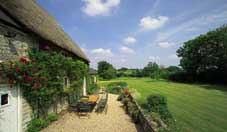Pros and cons: de-listing your property
De-listing your period property can be an arduous task but there are benefits for some owners


Rich in architectural history and character, listed properties are an irresistible draw for many property buyers. But with the prestige of listing also come restrictions on the alterations you can carry out and, often, hefty insurance bills. Dawn Carritt, a director of Jackson-Stops & Staff, believes that ‘the advantages of a listed house outweigh the disadvantages'.
A property is, after all, listed by English Heritage if it is deemed to be of special architectural, historical or cultural significance. Nonetheless, in these straitened times, when most owners want to minimise complications, applying to have your house removed from the listing register may suddenly look tempting.
Enjoying the beauty of an old house with the freedom of a new-build, where you don't need to be granted listed-building consent to add a conservatory-and you don't have to pay higher insurance premiums-could give you the best of both worlds. Getting a property de-listed, however, can be difficult.
The success rate of de-listing requests is 50/50-typically, only half of about 150 applications a year are approved. Among the circumstances in which your house can be taken off the register are ‘when serious damage has occurred accidentally, or it can be proved the property was listed in error,' explains Miss Carritt. ‘Another possibility is when the house has been substantially altered. But appealing on these grounds could be dangerous, as alterations require listed-building consent, and any undertaken without it would have to be removed by the current owner.'
A good example of a de-listing request is when a house has been destroyed by fire, obliterating all features of architectural and historical significance. The discovery that incorrect importance has been attributed to a property-‘the 17th-century fireplace wasn't designed by Robert Adam after all, or the king didn't sign that important document in your house, but up the road in the pub'-might also get you taken off the list, advises property lawyer Suzanne Bowman from Adams & Remers.
The process of de-listing takes about five months, and starts with registering with English Heritage (www.english-heritage.org.uk) and filling out an online form. Mrs Bowman says you need evidence, ‘including photographs, surveys and, in some cases, expert representation to present your case'. An inspection is usually made by English Heritage, and a report is then sent to the owner, applicant, local planning authority and national amenity societies, who have 21 days to respond.
Property consultant Tim Lawson from Property Path-finder helped a client attempt to de-list a former rectory on the Oxford/Gloucestershire border. ‘It wasn't of architectural importance and had been badly damaged by flooding. The owner was faced with a complete refurbishment, with costs exceeding the building's value.' The local conservation officer supported the proposal to de-list the house and replace it with a new dwelling. After a second appraisal by a historic-buildings inspector, however, the application was rejected on the basis that some of the property's original 17th-century fabric remained.
Sign up for the Country Life Newsletter
Exquisite houses, the beauty of Nature, and how to get the most from your life, straight to your inbox.
Chris Surfleet, an associate director in Savills' planning team, has come across only one de-listing success in his career: an over-zealous barn conversion that effectively removed the value of the original building. With such low odds, why bother trying to de-list? Mr Surfleet believes that ‘if you have a robust case, and it costs nothing to apply, the potential rewards could be worth all the effort, saving you a great deal of money and angst in the long run'.
The pros and cons of losing a listing
Pros
- You won't have to pay for expensive pipes and tiles
- Your house will appeal
to buyers wary of planners
- Insurance for an unlisted property usually costs less
Cons
- Losing a listing could detract from a property's value
- A listing is regarded as
an asset by many buyers
- De-listing can be arduous and, in some cases, expensive
Country Life is unlike any other magazine: the only glossy weekly on the newsstand and the only magazine that has been guest-edited by HRH The King not once, but twice. It is a celebration of modern rural life and all its diverse joys and pleasures — that was first published in Queen Victoria's Diamond Jubilee year. Our eclectic mixture of witty and informative content — from the most up-to-date property news and commentary and a coveted glimpse inside some of the UK's best houses and gardens, to gardening, the arts and interior design, written by experts in their field — still cannot be found in print or online, anywhere else.
-
 Josephine Baker and the remarkable women of espionage who helped win the Second World War
Josephine Baker and the remarkable women of espionage who helped win the Second World WarOn the 80th anniversary of VE Day, we salute five women who worked tirelessly in the shadows to bring about an Allied victory.
By Alan Mallinson Published
-
 10 outstanding British gardens from the Country Life Archive
10 outstanding British gardens from the Country Life ArchiveWith Chelsea Flower Show is on the horizon, we've mined the 128-year-old Country Life Archives for 10 inspiring gardens from across our Isles.
By Melanie Bryan Published
